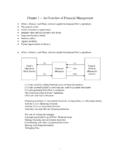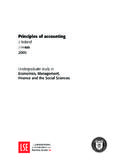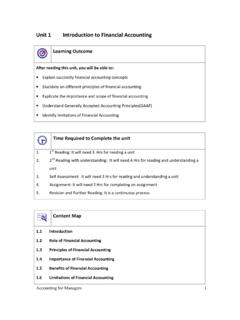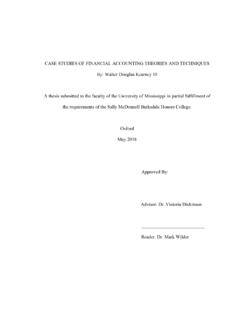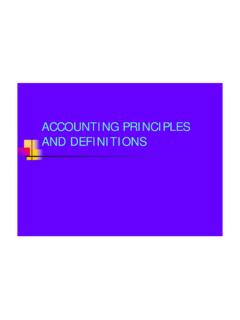Transcription of Guide for Accounting Officers - National Treasury
1 Guide for Accounting Officers Public finance Management Act Guide for Accounting Officers Public finance Management Act National Treasury Republic of South Africa October 2000 ISBN: 0-621-30219-8 To obtain additional copies of this document, please contact: The Librarian Department of finance Private Bag X115 Pretoria 0001 South Africa Tel: +27 12 315 5948 Fax: +27 12 315 5160 E-mail: The document is also available on the Internet at: Comments on this document should be submitted to Jayce Nair Tel: (012) 315-5482 E-mail: i PREFACE This Guide for Accounting Officers is the main Guide in a series of publications designed to help Accounting Officers implement the changes brought about by the introduction of the Public finance Management Act of 1999. This Guide updates and significantly expands on the preliminary versions distributed in March and July 2000.
2 The PFMA is a key element in a set of reforms to the management of government finances. Implementing the Act represents a major challenge for the public sector. If the objectives of the Act are to be achieved successfully, all stakeholders will need to change their way of working. The Act emphasises the importance of good management and accountability, and clarifies the accountability chain by defining the division of responsibilities between Accounting Officers and their Ministers or MECs. The Act recognises the importance of sound information for good management practices and for enabling the various stakeholders to fulfil their responsibilities. Chapters 1 and 2 of the Guide set out the philosophy behind the drafting of the PFMA and assists stakeholders in understanding their responsibilities under the Act.
3 These chapters explain the impact of the changes for the Accounting Officers of National and provincial departments at each step of the planning, implementing, monitoring and reporting cycle. The National Treasury has produced the Guide to help improve financial management, but recognises that the process of implementation will be a collective learning experience for all concerned. Complete implementation of the Act is expected to take several years, but significant and continuous improvements can and must be achieved over the next 12 months. Chapter 3 outlines these priorities for implementation, and should be regarded as the most important chapter. Many of these urgent steps are basic to any organisation, and are concerns only because of past neglect.
4 Addressing the priorities set out in Chapter 3 will enable Accounting Officers to manage their departments more effectively, and will lay the basis for improved service delivery by those departments. The chapters that follow expand on Chapter 3. The Guide emphasises that the PFMA must be read with the three sets of Treasury Regulations issued for departments, public entities and payroll deductions respectively. In addition, given the complex system of intergovernmental and labour issues, the Division of Revenue Act of 2000 and the Public Service Regulations are also relevant. This Guide does not include detailed information on public entities a separate document will be published in due course. The Guide for Accounting Officers is intended to facilitate a general understanding and assist in the smooth implementation of the PFMA.
5 An informal approach has been followed to make the Guide as user friendly as possible. It is not a substitute for the Act and should not be used for legal interpretations. This Guide does not in any way detract from the responsibilities Parliament and the legislatures expect all Accounting Officers to fulfil in terms of the PFMA. Maria Ramos Director-General: National Treasury ii ABBREVIATIONS ASB Accounting Standards Board CFO chief financial officer DoRA Division of Revenue Act Exco Executive Council FOSAD Forum of (South African) Directors-General GRAP generally recognised Accounting practice KPI key performance indicator MEC Member of the Executive Council (of a province) MTEF Medium Term Expenditure Framework NGO Non-governmental organisation NRF National Revenue Fund PFMA Public finance Management Act, No.
6 1 of 1999, as amended PPP public-private partnership RDP Reconstruction and Development Programme SCOPA Standing Committee on Public Accounts iii CONTENTS PREFACE i ABBREVIATIONS ii 1. introduction 1 Purpose of this 1 Background to the 1 Defining 2 Modernisation of financial 3 What is financial management?.. 3 Behavioural aspects of the 4 Approach to 5 5 2. Vision of the PFMA: performance budgets and accountability 7 Financial 7 Evaluation of 9 Accountability 10 Famous 14 3. Seven immediate steps 15 1. In-year management, monitoring and 16 2. Clear up audit 16 3. Establish effective internal 16 4. Improve expenditure management and 17 5. Banking 17 6. Complete financial statements on 18 7. Delegation of 18 18 4. Reporting and accountability 19 Best practice internal 19 In-year management, monitoring and 20 5.
7 Responsibilities and planning 25 Separation of 25 Delegation by executive 25 Delegation by Accounting 26 Responsibilities of Accounting 26 6. Corporate management and internal controls 27 Financial 27 Internal 28 Internal 31 Audit 32 7. Revenue, assets and liabilities 35 Revenue 35 iv Asset 37 Liability 38 Loans, borrowing and 38 8. Expenditure management 39 Unauthorised, irregular, fruitless and wasteful 39 Financial 40 In-year 42 Public-private partnership 43 9. Transfer payments and conditional grants 45 General 45 Division of Revenue 46 Other transfer 48 10. Cash and banking 49 Cash 49 Banking 49 Bank 49 Responsibilities of 50 11. Miscellaneous 53 Basic Accounting records and related 53 Trading 53 Oversight of public 54 Commissions and Committees of 55 Gifts, donations and 55 Payments, refunds and remissions as an act of 55 12.
8 Implications for executive authorities 57 13. The way forward 61 Key success 61 National and provincial 61 Capacity 62 Annexure A: Exemptions 63 Annexure B: Reporting formats 65 Annexure C: Disciplinary procedures 75 Annexure D: Structure of the PFMA 79 Annexure E: Glossary 81 1 1 introduction Purpose of this Guide This Guide is designed to familiarise Accounting Officers with the changes to their responsibilities that were introduced by the Public finance Management Act (PFMA), a key element in a series of government budget and finance reforms. This introductory chapter explains the rationale behind the Act and accompanying Treasury Regulations, and the behavioural changes necessary to upgrade financial management throughout Government. Chapters 1 and 2 are introductory and set out the context within which the Act has been drafted and the vision its seeks to achieve.
9 Chapter 3 details the most urgent steps Accounting Officers will be expected to address in the next 6 12 months. The remainder of the Guide provides more detail on implementing the steps in Chapter 3, and concludes with sections dealing with the responsibilities of executive authorities and the way forward. Background to the Act Government has prioritised the transformation of the public sector to enable it to meet the needs of the people and the objectives of the Reconstruction and Development Programme (RDP). Given the enormous demand for services and the limited resources available to satisfy that demand, all available resources must be used as effectively and efficiently as possible. Government is determined to modernise the management of the public sector, to make it more people friendly and sensitive to the communities it serves.
10 Budgetary and financial reforms were initiated soon after the 1994 elections. The first phase of reforms began with the introduction of a new intergovernmental system, which required all three spheres to develop and adopt their own budgets (decentralised budgeting). This was complemented by a system of significant transfers to provinces and municipalities. In addition, multi-year budgeting through the Medium-term Expenditure Framework (MTEF) was introduced in 1997/98 to replace the one-year incremental system. The final elements in this phase of reforms were to deepen the budget process and better align policy, planning and budgeting. The adoption and implementation of the PFMA signalled the second phase of the programme of reforms.










